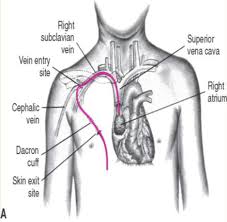A CVAC is a tube that is inserted beneath your skin so there is a simple, pain-free way for doctors or nurses to draw your blood or give you medication or nutrients. When you have a CVAC, you are spared the irritation and discomfort of repeated needlesticks. More than 3.4 million CVACs are placed each year, and doctors increasingly recommend their use. There are several types of CVACs, including tunneled catheters (Hickman or Broviac), peripherally inserted central catheters (also called PICC lines or long lines), dialysis catheters, and implantable ports. Interventional radiologists also open up blocked hemodialysis grafts, using procedures such as angioplasty or thrombolytic therapy.

What is a Central Venous Access Catheter or CVAC?
A CVAC is a tube that is inserted beneath your skin so there is a simple, pain-free way for doctors or nurses to give you nutrients, or to draw your blood. When you have a CVAC, you are spared the irritation and discomfort of repeated needle injections. Doctors recommend CVACs for patients who regularly undergo dialysis or chemotherapy treatments, or for patients who frequently receive antibiotic or antifungal infusions or nutritional supplements.
A device used to draw blood and give treatments, including intravenous fluids, drugs, or blood transfusions. A thin, flexible tube is inserted into a vein, usually below the collarbone. It is guided (threaded) into a large vein above the right side of the heart called the superior vena cava. A needle is inserted into a port outside of the body to draw blood or give fluids. A central venous access catheter may stay in place for weeks or months and helps avoid the need for repeated needle sticks. There are several types of central venous access catheters.
A CVAC is a tube that is inserted beneath your skin so there is a simple, pain-free way for doctors or nurses to draw your blood or give you medication or nutrients. When you have a CVAC, you are spared the irritation and discomfort of repeated needle sticks. More than 3.4 million CVACs are placed each year, and doctors increasingly recommend their use. There are several types of CVACs, including tunneled catheters (Hickman or Broviac), peripherally inserted central catheters (also called PICC lines or long lines), dialysis catheters, and implantable ports.
Equipment
In this procedure, x-ray and ultrasound equipment, a needle, a guidewire, and a vascular access catheter are used.
The equipment typically used for this examination consists of a radiographic table, an x-ray tube, and a television-like monitor that is located in the examining room or in a nearby room. When used for viewing images in real-time (called fluoroscopy), the image intensifier, which converts x-rays into a video image, is suspended over the table on which the patient lies. When used for taking still pictures, the image is captured either electronically or on film. The x-ray equipment allows the operator to watch the wire and catheter on a live display so they can be inserted safely and positioned to allow the catheter to function best.
Ultrasound scanners consist of a console containing a computer, a video display screen, and a transducer that is used to scan the body. Ultrasound is used to assess the vein that is being used for catheter placement and to provide guidance during the venous puncture. It is important to use ultrasound guidance during the venous puncture to reduce the risk of possible complications such as bleeding. Ultrasound also allows the physician to find the best vein to use, locating veins that are large but deeper than can be felt or seen.
A catheter is a long, thin plastic tube, about as thick as a strand of spaghetti. In contrast to the catheter used in a standard intravenous (IV) line, a vascular access catheter is more durable and does not easily become blocked or infected. These catheters are designed in a way that they extend into the largest central vein near the heart.
The following are the major types of vascular access catheters:
1) A peripherally inserted central catheter (PICC) is a long catheter that extends from an arm vein into the largest vein near the heart, the superior vena cava, and typically provides central IV access for several weeks but may remain in place for several months. These catheters are called “midline catheters” when they are placed in a way that the tip of the catheter remains in a relatively large vein but does not extend into the largest central vein. They may have one or two lumens, and some may be able to be used for CT contrast injections (manufactured for forceful injections).
2) A non-tunneled central catheter is larger caliber than a PICC and is designed to be placed via a relatively large, more central vein such as the jugular vein in the neck or the femoral vein in the groin.
3) A tunneled central catheter has a cuff that stimulates tissue growth that will help hold it in place in the body. The tunneled catheter is the best choice when access to the vein is needed for a long period of time. It is secure and easy to access. They are more secure and usually work more efficiently than PICCs because of their design (cuff on the catheter stimulating tissue growth) and larger size. This type of catheter has portions that hang outside the skin and is used by connecting directly to the outside ports of the catheter. The patient does not get stuck directly when the catheter is used. This type of catheter must be protected from getting pulled or getting wet.
4) A port catheter, or subcutaneous implantable port, is a permanent device that consists of a catheter attached to a small reservoir, both of which are placed under the skin similar to tunneled catheters. This catheter is used completely under the skin. The patient’s skin is punctured every time the catheter is used, but there are no restrictions on showering or bathing.
